Category Archives: Fish Profile
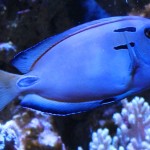
Vampire Tang
Common Name: Vampire tang, Lieutenant Tang, Doubleband Surgeonfish
Scientific Name: Acanthurus Tennenti
Reef Safe: Yes
Temperament: Semi Aggressive
Care Level: Moderate
Max Size: 10 inches (8 to 9 inches is more common)
Appearance:
The vampire tang will range in color from light tan to white with an almost black border around the edges of the body. They are also known to have a really nice blue outline around the head and fins. Once the vampire tang reaches adult size, the tailfin will also develop some very nice blue and white coloring and take on a lyre shape. And of course, there are the two dark blue to black markings on the shoulder area just behind the head. As juveniles, they will have a horse shoe shaped marking on their side which will separate into the two dark marking once they start to reach adulthood. These adult markings will also have a very vibrant blue outline to them.
May people find these marking to look like vampire teeth while others will believe the markings look closer to the rank insignia for an army lieutenant. This is how the two most common names for this fish had developed.
Below are a few pictures of my vampire tang. I would guess he is fully grown as he has reached 9 inches in length and has stayed that way for about 2 to 3 years now. My photography skills do not allow me to truly show you how nice this fish really looks. The body on my vampire tang is almost white in color making it hard to me to get a good picture as his body reflects the blue tones of the aquarium lighting which gets picked up by the camera.
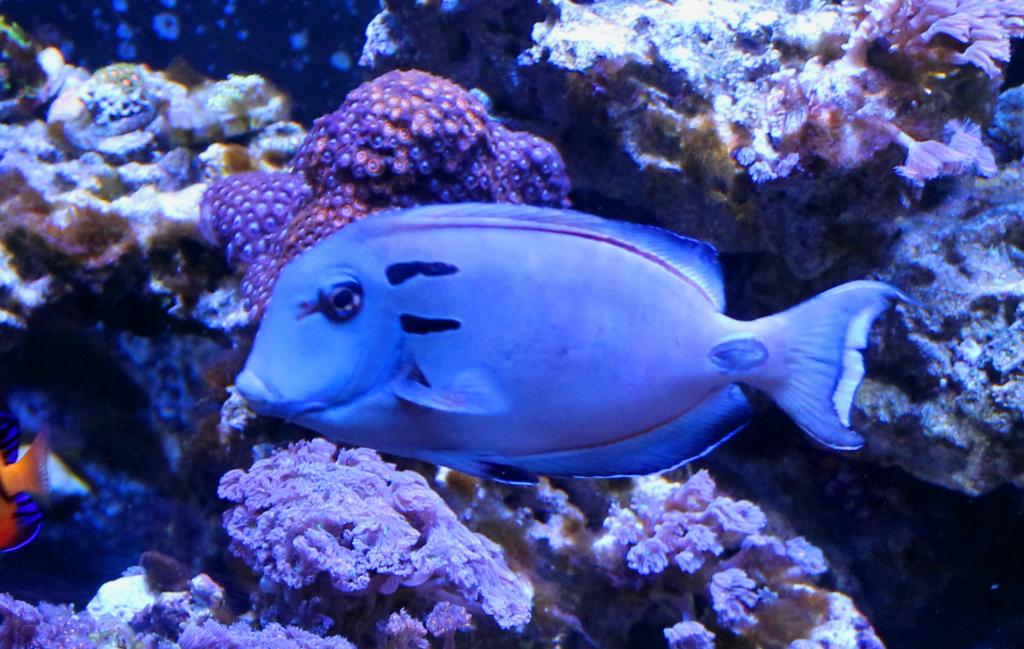
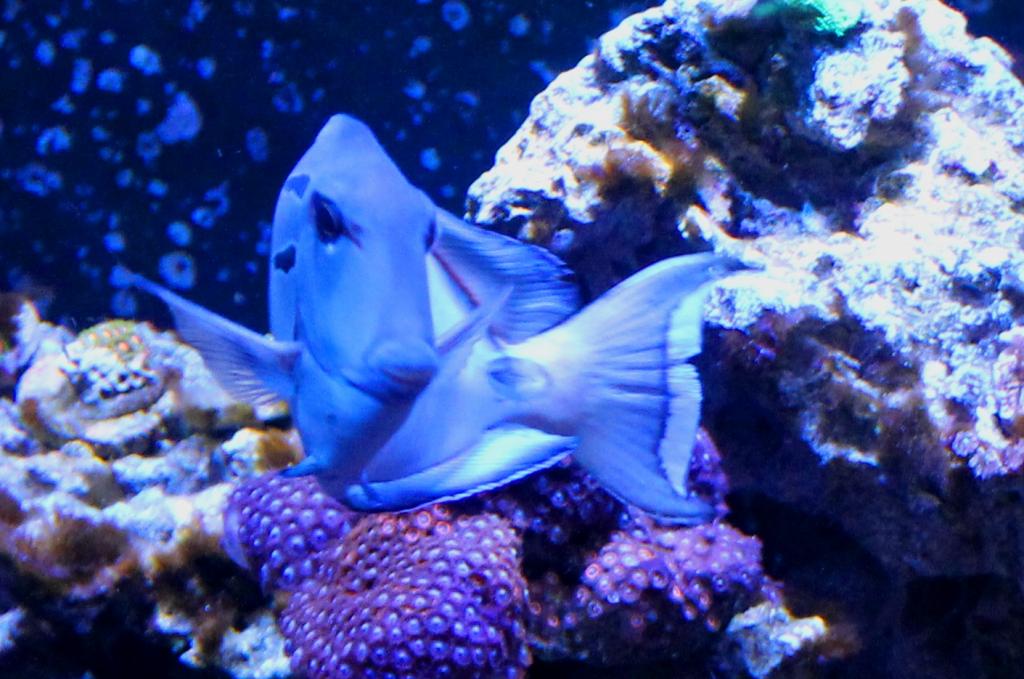
Environment and Temperament
Vampire tangs can become semi-aggressive when kept with other tangs of a similar shape, size, and color to them and can also become aggressive with other vampire tangs in the same aquarium. This behavior would be fairly common with most tangs. The vampire tang however is a great fish for a community tank as they will peacefully co-exist with any other types of fish. They are also completely reef safe.
The vampire tang would need an aquarium size of 150 gallons, but would do best in a 180 gallon (or larger) aquarium. The reason for that recommendation is not only based on their average adult size of around 10 inches (give or take), but on their typical behavior as well. They are a very active fish requiring a lot of open swimming space in the tank. This can also make the vampire tang a very entertaining fish to have in a properly sized set-up.
The vampire tang will do best when there are a few suitable hiding spots so they can claim one as their own. As with most tangs, they like to go a hide when they get scared or startled. Having a good amount of live rock in your tank will not only help you to maintain good water parameters, but also provide a more natural environment for the vampire tang.
Recommended water conditions / parameters:
I would refer you to the below article for the typical water conditions that vampire tangs will do best in:
https://www.reefaquarium.com/2013/the-basics-of-marine-aquarium-water-parameters/
Diet
As with most tangs, the vampire tang will accept almost any food you may offer it. However, they are herbivores and will require a diet consisting mostly of sea algaes with some other verities of food on occasion. A good quality flake or pellet food meant for marine herbivores is also a good option for the vampire tang’s main diet.
A reference to consider
https://www.reefaquarium.com/2013/responsible-fish-keeping/
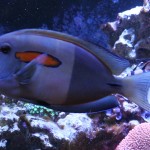
Orange Shoulder Tang
Common Name: Orange Shoulder Tang. Orange Spot Tang, Orange Epaulette Tang, Orangeband Surgeonfish
Scientific Name: Acanthurus Olivaceous
Reef Safe: Yes
Temperament: Peaceful to Semi aggressive
Care Level: Easy
Max Size: 12 inches (9 to 10 inches is more common)
Appearance:
The orange shoulder tang will have a different appearance as a juvenile. When in this stage, they will be mostly yellow in color with very subtle and faint blue highlights. The bar shaped marking on the side of their body will be a shade of orange to brown. Once they have reached adulthood, the front half of their body will turn a very light grey color while the back half will be a darker shade of grey. Their tail will develop a lyre shape to it over time as well. The bar marking on the side will turn to a vibrant orange color as well as developing a blue border around it. They will also develop blue and orange highlights around the edges of their body and fins.
The below pictures are of my orange shoulder tang. I would guess he has reached his fully grown adult size of about 10 inches as he has not grown at all in the past 3 or 4 years
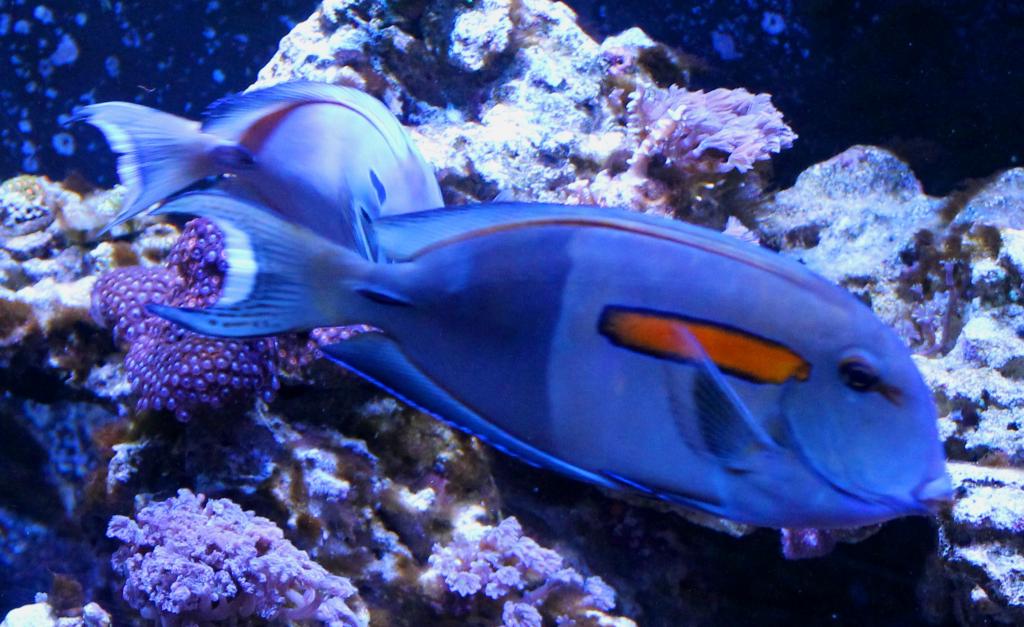
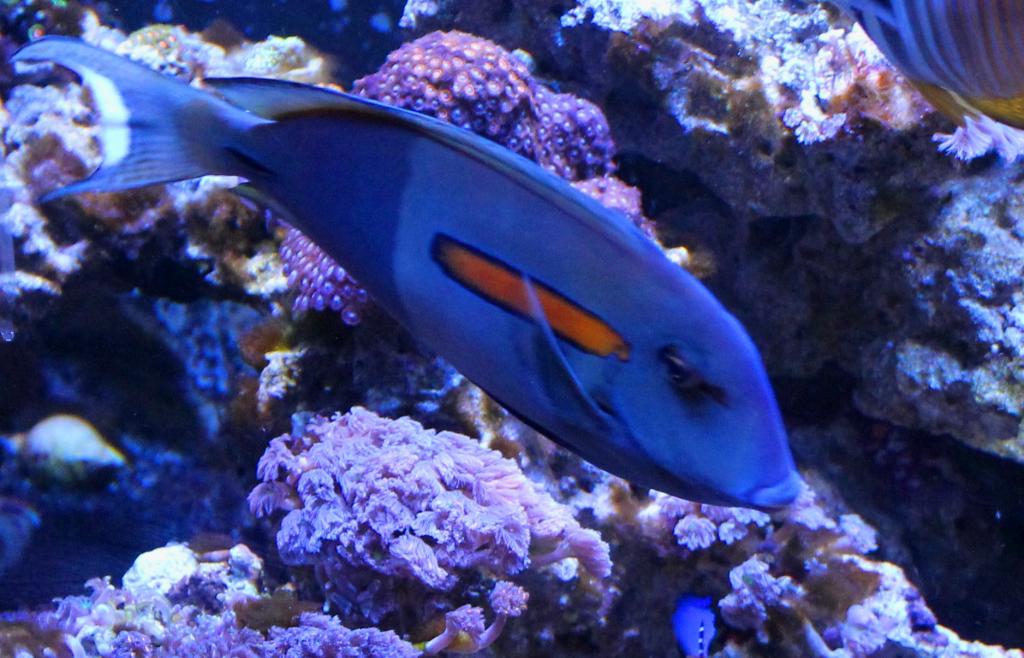
Environment and Temperament
Orange shoulder tangs are the least likely to become semi-aggressive when kept with other tangs of a similar shape, size, and color to them. However, there still is a small risk they can become aggressive with other orange shoulder tangs in the same aquarium if not added at the same time and as juveniles. The orange shoulder tang is the least aggressive tang amount all of the larger bodied tangs common in the hobby. They are also a great fish for a community tank as they will peacefully co-exist with any other types of fish. They are typically reef safe when they are kept well fed.
The orange shoulder tang would to best in a tank size of 180 gallons or more. I would not suggest keeping one in an aquarium smaller than 180 gallons. The reason for that recommendation is not only based on their average adult size of around 10 inches (give or take), but on their typical behavior as well. They are a very active fish requiring a lot of open swimming space in the tank.
The orange shoulder tang will require a few suitable hiding spots so they can claim one as their own if spooked or startled. Having a good amount of live rock in your tank will not only help you to maintain good water parameters, but also provide a more natural environment for the orange shoulder tang as they like to pick at algae as it develops on your live rocks. If you are interested you can check this live rock for sale online.
Recommended water conditions / parameters:
I would refer you to the below article for the typical water conditions that orange shoulder tangs will do best in:
https://www.reefaquarium.com/2013/the-basics-of-marine-aquarium-water-parameters/
Diet
As with most tangs, the orange shoulder tang will accept almost any food you may offer it. However, they are herbivores and will require a diet consisting primarily of sea algaes with some other verities of food on occasion. A good quality flake or pellet food meant for marine herbivores is also a good option for the orange shoulder tang’s main diet.
I have read about people offering lettuce to orange shoulder tangs as a part of their diet. I would not recommend this practice. Although the orange shoulder tang will eat it, lettuce will not offer the same required nutrients as compared to marine algaes.
A reference for you consideration
https://www.reefaquarium.com/2013/responsible-fish-keeping/
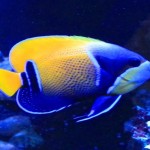
Majestic Angelfish
Common Name: Majestic Angelfish, Blue Gilled Angelfish
Scientific Name: Pomacanthus Navarchus
Reef Safe: No
Temperament: Semi-Aggressive
Care Level: Moderate
Max Size: 12 to 14 inches (8 to 10 is more common)
Appearance:
This is a very colorful angelfish. It has a yellow color with darker blue markings on the body and a blue band on the head which included the eyes. There also will be a light blue edging that will separate the dark blue and orange coloring on most of this fish’s body. The fins are also blue with a lighter blue to orange like boarder around the edges.
Juvenile majestic angels will have a different appearance. They will have a black to dark blue colored body with orange to yellowish to orange tint or undertone to the color which shows under certain lighting conditions. Their bodies will also have vertical stripes that are more of a light blue color with a very slight orange tint to them as well.
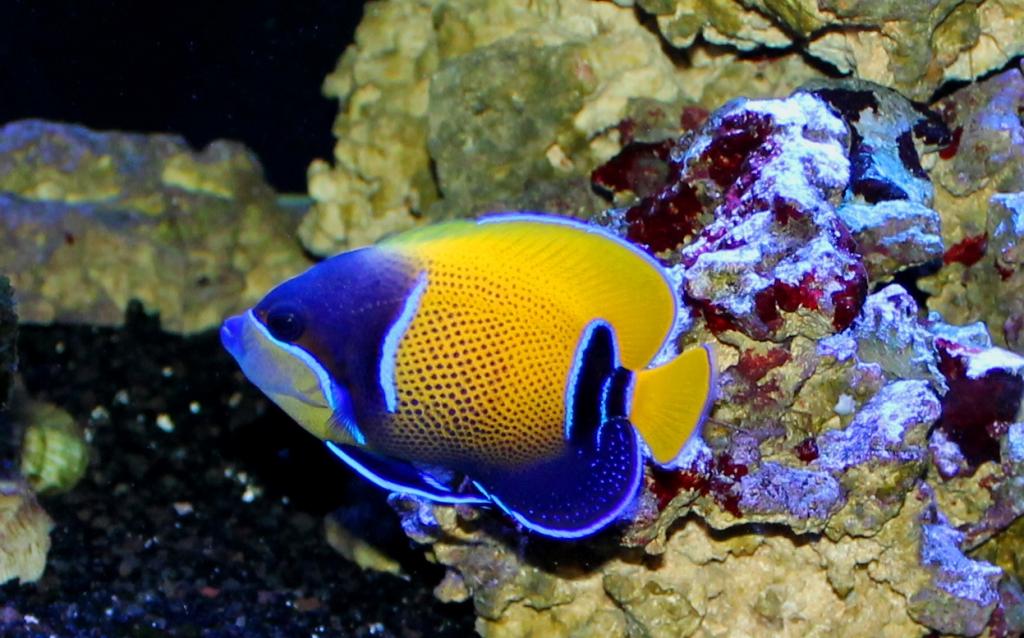
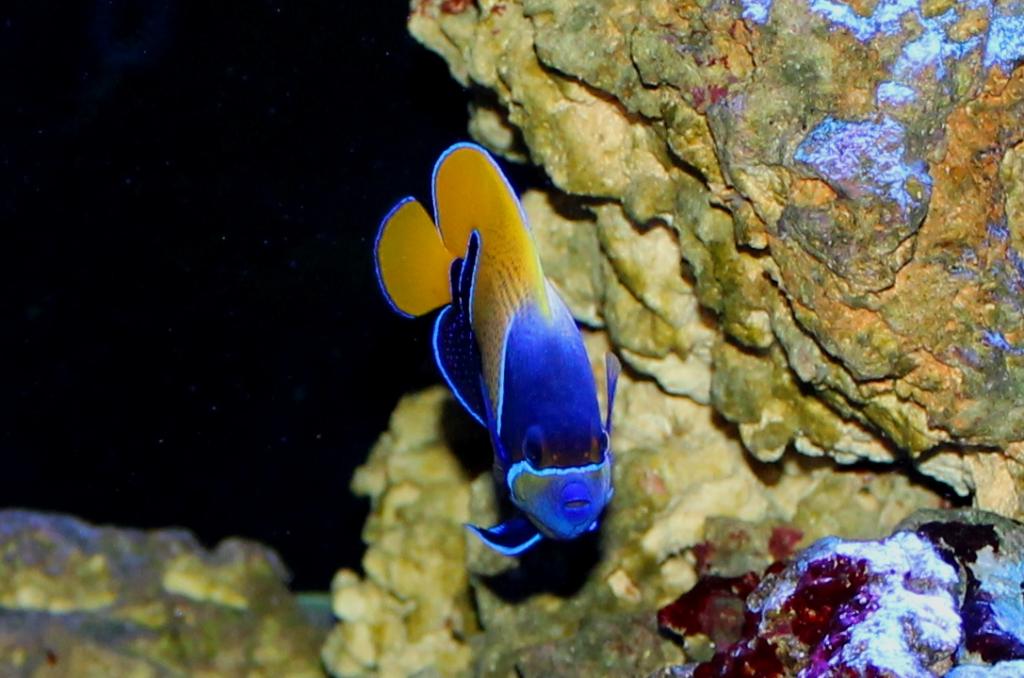
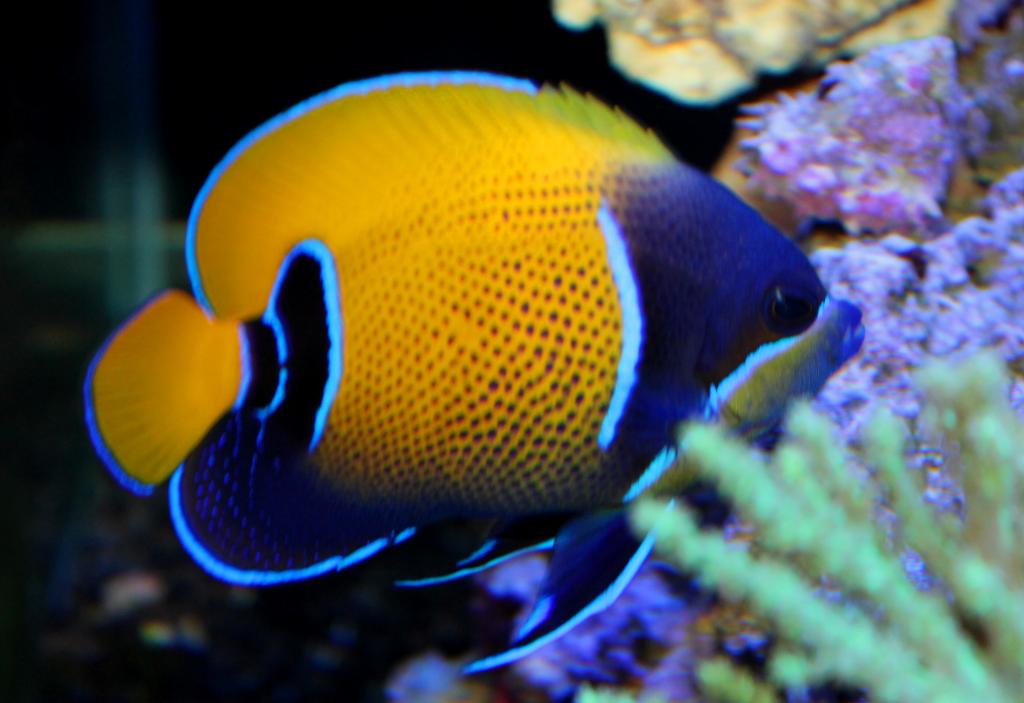
Temperament
This can be a territorial fish and should be kept as the only majestic angelfish in an aquarium. It should not be kept with other territorial fish or other angels. They have been known to nip at clam mantels and, in rare cases, anemones as well. They will do best in a FOWLR set-up with other peaceful fish or a reef tank with SPS corals.
Environment
This fish will need at least a 120 gallon FOWLR set-up with many hiding spots appropriate for its fully grown size. As they can be very sensitive to water quality, it would be best to introduce this fish to a matured set-up. They will also need large amounts of live rock to pick at as well as hid in.
Recommended water conditions:
I would refer you to the below article for the typical water conditions that a Majestic Angelfish will do best in. As with most of the larger bodied angelfish, they need very good and very stable water conditions for long-term success.
https://www.reefaquarium.com/2013/the-basics-of-marine-aquarium-water-parameters/
Diet
This angelfish (as with most angelfish) are omnivores. They can be picky eaters making them difficult to switch them over to frozen and flake or pellet foods.
Once they start eating, they will accept almost any food you may offer it. However, they are omnivores and will require a diet consisting a good amount of algaes with some other verities of meaty foods and foods containing sponges as well. A good quality flake or pellet food meant for marine angel fish that contains the same nutrients as sponges is also a good option for the their main diet.
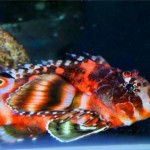
Fu Manchu Lionfish
Common Name: Fu Manchu Lionfish, Ocellated Lionfish, Twinspot Lionfish
Scientific Name: Dendrochirus Biocellatus
Reef Safe: Yes
Temperament: Predator, but peaceful in the right set-up
Care Level: Moderate to difficult
Max Size: 4 inches
Appearance:
The Fu Manchu is among the more interesting and beautiful of the dwarf lionfish. It has very vibrant and contrasting colors of black brown, red and white. The Fu Manchu also has a unique feeler like tentacles at the corners of it’s mouth.
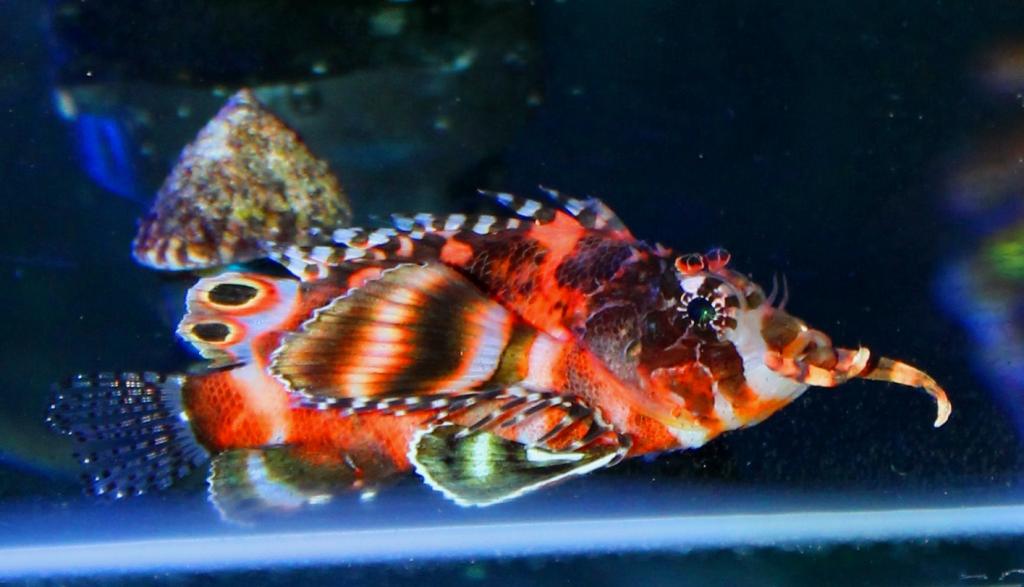
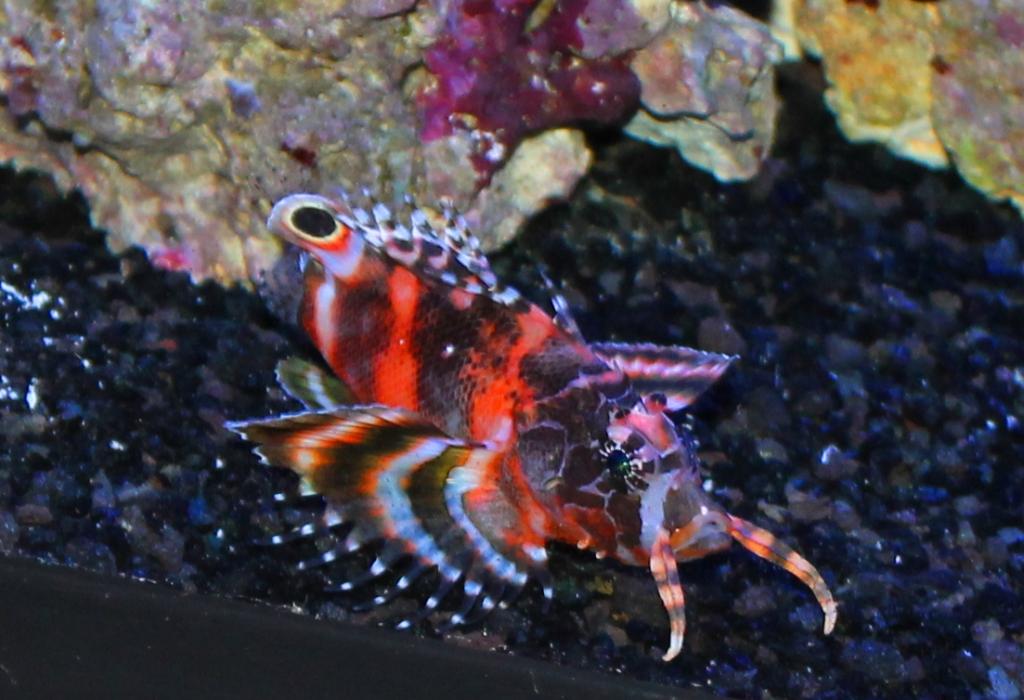
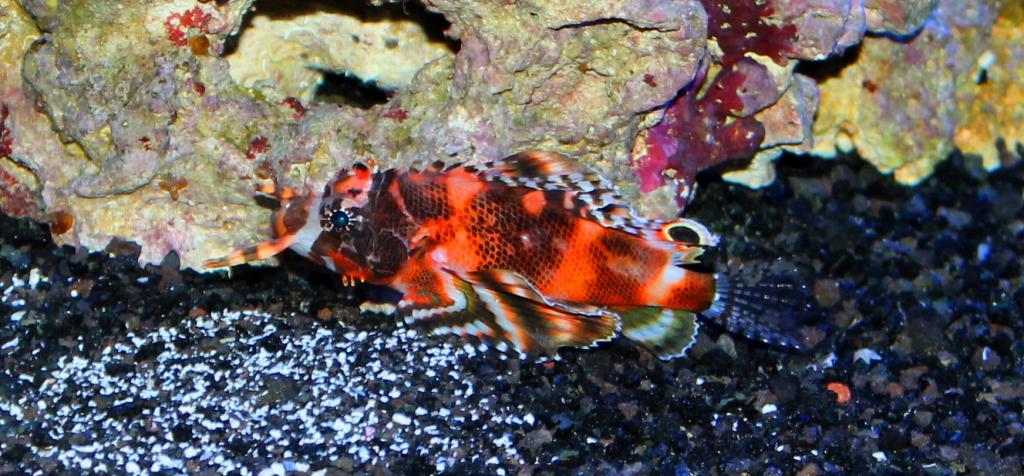
Temperament
They will do perfectly fine with other fish of similar size and can be a very peaceful community fish when kept with the correct tank mates. They can be a very shy fish that will not do well with other semi-aggressive fish. However, when kept with fish that have a body size of about ½ of the lionfish’s body size; it will only be a matter of time before the Fu Manchu lionfish will try to eat it. They are among the better predators common in the hobby. Although you can keep multiple Lionfish in the same aquarium, you should use caution when doing so. You would need to ensure they are both a very similar size and added at the same time to increase your chances of success. One of the Lionfish can become very dominant and will bully the others steeling all the food when you feed the tank.
Environment
I would suggest a 36 inch long, 30 gallon aquarium would be the minimum size for the Fu Manchu lionfish based on its potential fully grown size. They need swimming space both around rocks and out in the open. They do best when provided shelf like structures which they can hang up-side from as well as cave structures they can sit in. This lionfish can be kept with corals. They have been known to eat smaller fish and shrimp (members of a tank’s cleanup crew) which cause many people not to add them to a reef aquarium.
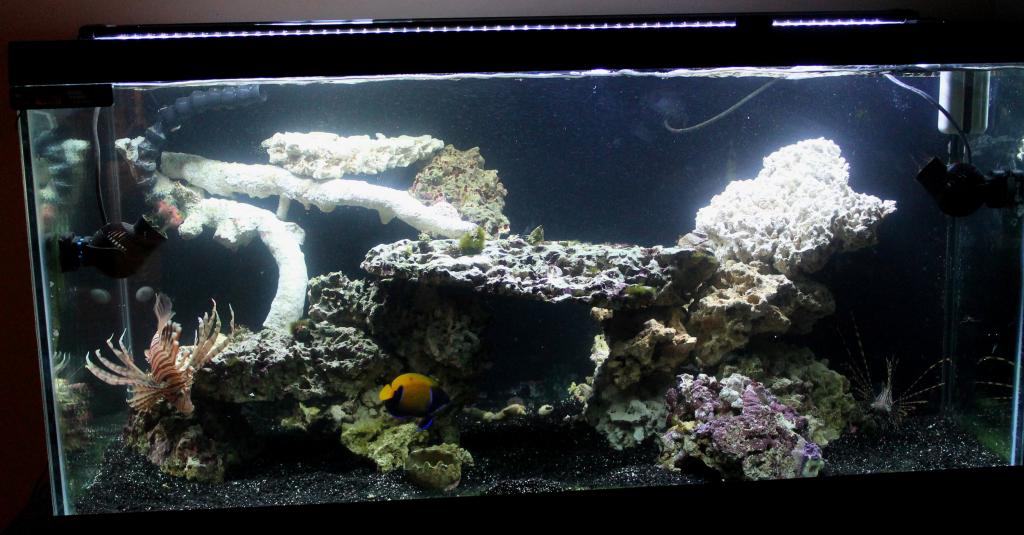
Recommended water conditions:
I would refer you to the below article for the typical water conditions that a Fu Manchu lionfish will do best in. As a more difficult fish to keep, the Fu Manchu will also need both good and stable water parameters for long term success.
https://www.reefaquarium.com/2013/the-basics-of-marine-aquarium-water-parameters/
Diet
These predators are naturally carnivores. Getting this Lionfish to eat a healthy diet for it’s long term health is one of the biggest reasons for hobbyist having difficulties keeping lionfish. As the Fu Manchu lionfish is a predator, they are used to eating live fish that are anywhere about ½ their body size or less. It can be difficult to get them to switch to eating meaty frozen foods and/or pellets for marine carnivores.
I have had great success by using a very long pair of tweezers to take a smaller and longer peace of frozen food and wiggling it in the aquarium near the lionfish. This makes it look alive and the lionfish will typically eat it after a few days to a week of trying. Other hobbyist has also had great success with this approach by sticking the food on a small wood stick (like you use to make shish kabob). Once they are eating the wiggling food and have gotten used to it, I will start to wiggle the food less and less slowly getting them used to eating food that doesn’t look alive. Once they are at this point, you can just add the food to the tank and they will “hunt” it down and eat it. This is why I always suggest buying a lionfish that is already eating frozen foods so the above process will be a lot easier for you.
The above process is a proven one that works. Many people get frustrated and give up trying only to offer the lionfish live foods like small feeder goldfish. I do not recommend feeding your lionfish feeder goldfish for two reasons; 1) freshwater fish to not have the same mineral and fatty tissues that marine fish have which will not provide the lionfish with the proper nutrients it will need for long-term health, and 2) The lionfish will always favor live food over frozen as that is instinctive to them. This will set-back your efforts to get the lionfish to eat frozen foods. I would not even offer a lionfish live foods as the occasional treat.
Once you get your lionfish eating frozen foods, they will need a variety of different meaty foods like: prawns, large Mysis shrimp. The below thread will give you some better ideas for feeding a lionfish a diet that will help them have along and healthy life in your tank.
Be careful not to overfeed a lionfish as they have been known to overeat to the point of creating an internal blockage if given the chance. Just feed enough until you see a slight bulge in their stomach. Feed every second day as juveniles and about three times a week as adults.
https://www.reefaquarium.com/2012/feeding-high-quality-froozen-foods/
Special considerations
1) Feeding by hand
I never recommend feeding your lionfish by hand. Although they will readily take the food form you, over time they will learn to associate your hand with feeding. When you try to put your hands in the tank for reasons other than feeding, the lionfish will still think they are about to get fed and swim up very close to your hand. That can put you at some risk of getting bit or stung depending on the exact personality of your lionfish
2) Venomous Spins
The long dorsal fin of the lionfish contains venomous spins. If you get stung by one, it is going the hurt a lot like a very bad bee sting, or at least that is what I have heard. If you get stung by one, soak the stung part in hot water (as hot as you can stand it) for about 15 or 20 minutes. If you see any signs of a allergic reaction, seek medical attention immediately. I have found the best way not to get stung (accidentally or otherwise) is to make sure you do not spook or corner the lionfish when you put your hands in the tank
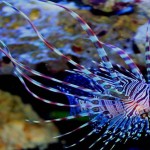
Volitan Lionfish
Common Name: Volitan Lionfish, Colored. Black Volitan Lionfish
Scientific Name: Pterois volitans
Reef Safe: Yes
Temperament: Predator, but peaceful in the right set-up
Care Level: Moderate
Max Size: 11 to 14 inches (refers to the body size excluding the fins, around 12 inches is more common)
Appearance:
This is one of bigger of the larger bodied lionfish. They have all the typical fins as with any of the larger lionfish. The coloring of their stripes will be brown to dark brown in color. It can be easy to mistake a Russels Lionfish with a volitan lionfish if you do not know what to look for. There are three key differences to look for. 1) The tailfin will have spots on it while the Russels will not2) The Russels bottom jaw and chin will also be white which while the volitan will have a color pattern on the bottom jaw 3) The spins along the dorsal, pectoral and anal fins on a russels lionfish are not banded and more fleshly in appearance while these same fins on a volitan are more sleek in appearance and will have dark colored banding on them.
The below pictures are of my black volitan lionfish about 5 months after I added him to my tank
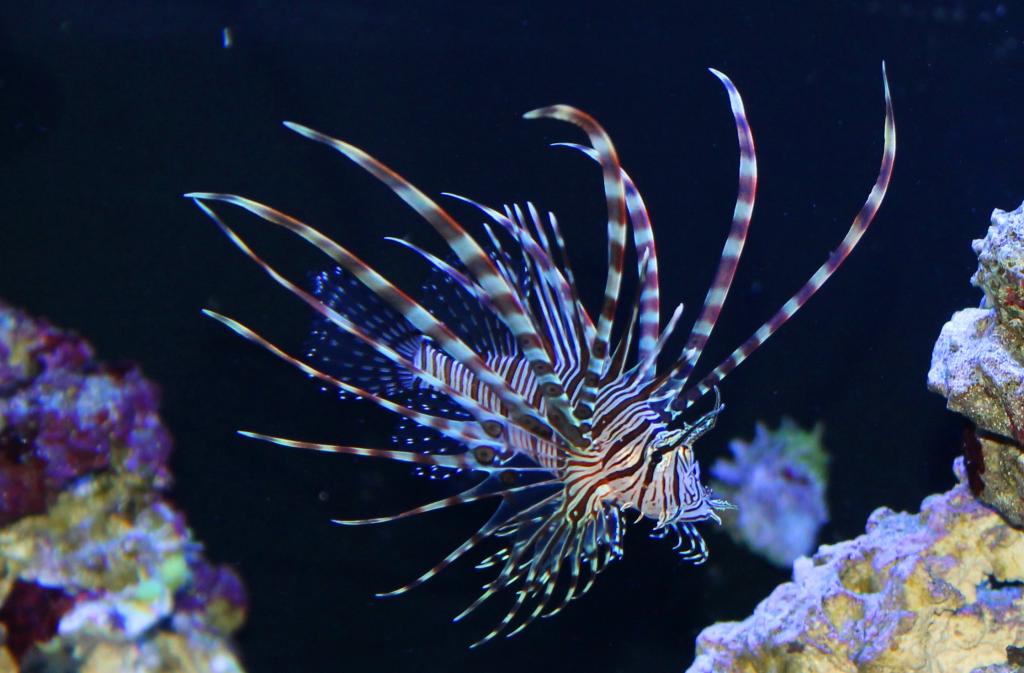
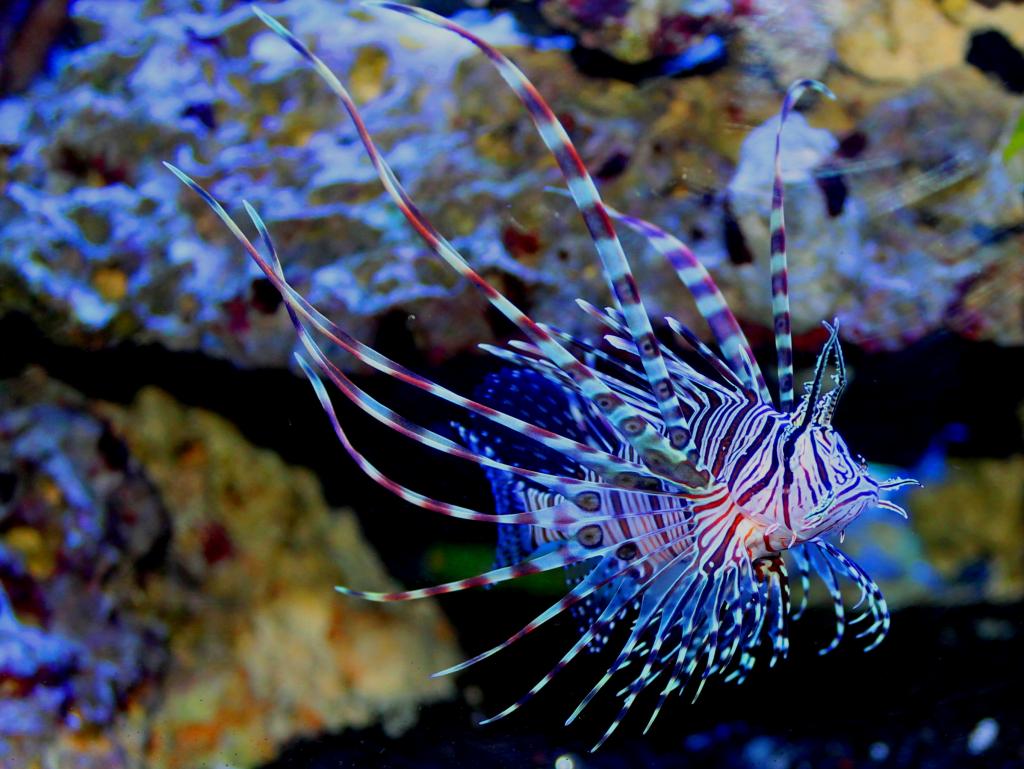
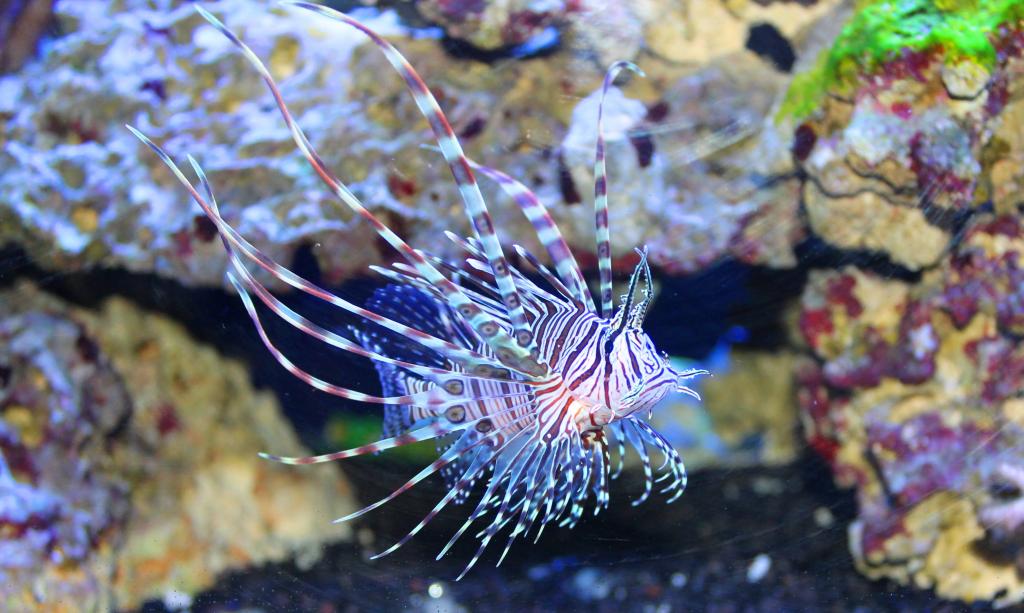
The below pictures are of the same lionfish 3 years later
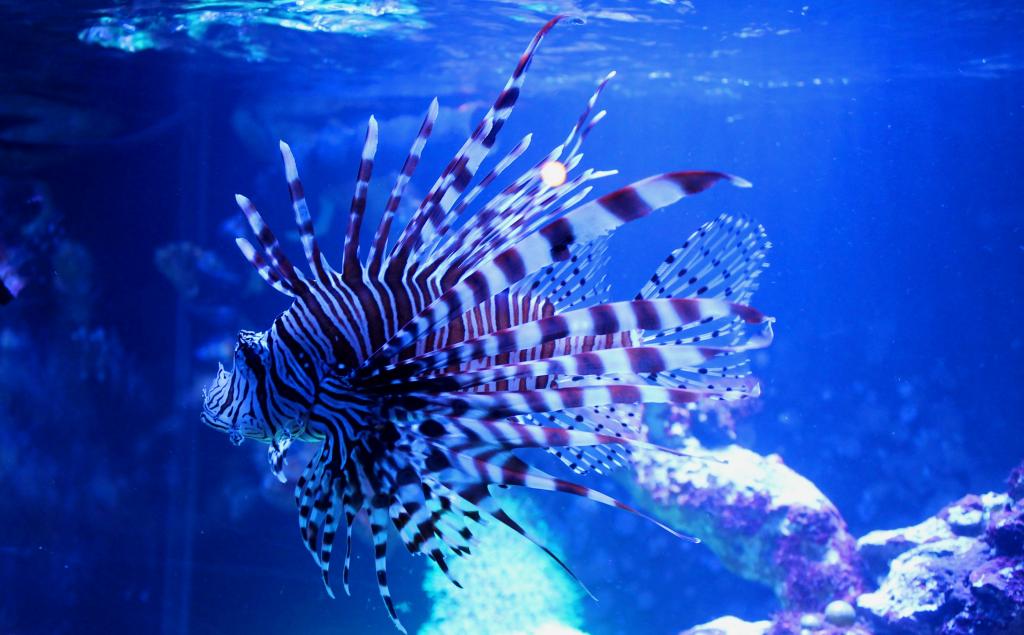
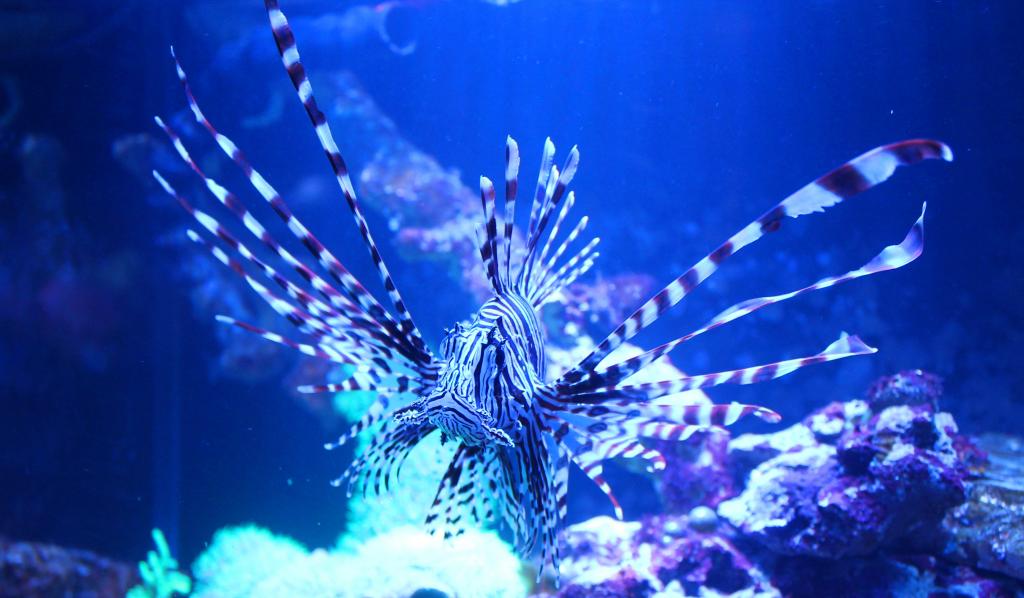
Temperament
They will do perfectly fine with other fish of similar size and can be a very peaceful community fish when kept with the correct tankmates. However, when kept with fish that have a body size of about ½ of the lionfish’s body size; it will only be a matter of time before the volitan lionfish will try to eat it. They are among the better predators common in the hobby. Although you can keep multiple Lionfish in the same aquarium, you should use caution when doing so. You would need to ensure they are both a very similar size and added at the same time to increase your chances of success. One of the Lionfish can become very dominant and will bully the others steeling all the food when you feed the tank.
Environment
I would suggest a 120 gallon aquarium (24 inches wide) would be the minimum size for the volitan lionfish based on its potential fully grown size. They need swimming space both around rocks and out in the open. They do best when provided shelf like structures which they can hang up-side from as well as cave structures they can sit in. The below is an example of both. Lionfish can be kept with corals. They have been known to eat smaller fish and shrimp (members of a tank’s cleanup crew) which causes many people not to add them to a reef aquarium.
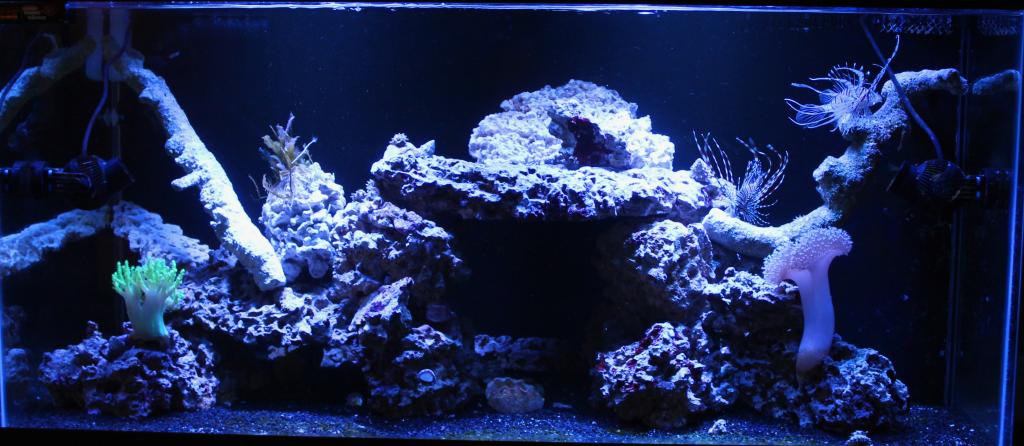
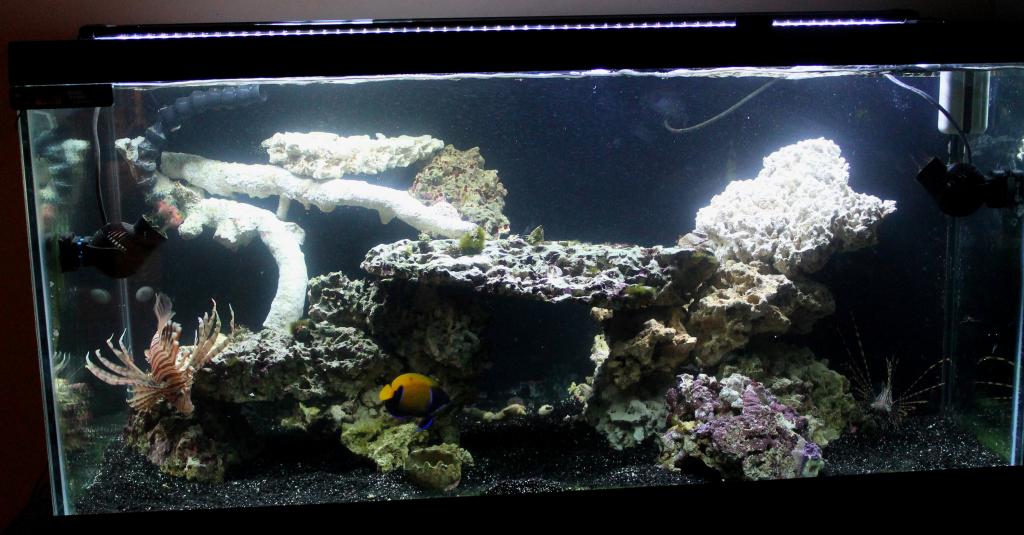
Recommended water conditions:
I would refer you to the below article for the typical water conditions that a volitan lionfish will do best in:
https://www.reefaquarium.com/2013/the-basics-of-marine-aquarium-water-parameters/
Diet
These predators are naturally carnivores. Getting this Lionfish to eat a healthy diet for it’s long term health is one of the biggest reasons for hobbyist having difficulties keeping lionfish. As the volitan lionfish is a predator, they are used to eating live fish that are anywhere about ½ their body size or less. It can be difficult to get them to switch to eating meaty frozen foods and/or pellets for marine carnivores.
I have had great success by using a very long pair of tweezers to take a smaller and longer peace of frozen food and wiggling it in the aquarium near the lionfish. This makes it look alive and the lionfish will typically eat it after a few days to a week of trying. Other hobbyist has also had great success with this approach by sticking the food on a small wood stick (like you use to make shish kabob). Once they are eating the wiggling food and have gotten used to it, I will start to wiggle the food less and less slowly getting them used to eating food that doesn’t look alive. Once they are at this point, you can just add the food to the tank and they will “hunt” it down and eat it. This is why I always suggest buying a lionfish that is already eating frozen foods so the above process will be a lot easier for you.
The above process is a proven one that works. Many people get frustrated and give up trying only to offer the lionfish live foods like feeder goldfish. I do not recommend feeding your lionfish feeder goldfish for two reasons; 1) freshwater fish to not have the same mineral and fatty tissues that marine fish have which will not provide the lionfish with the proper nutrients it will need for long-term health, and 2) The lionfish will always favor live food over frozen as that is instinctive to them. This will set-back your efforts to get the lionfish to eat frozen foods. I would not even offer a lionfish live foods as the occasional treat.
Once you get your lionfish eating frozen foods, they will need a variety of different meaty foods like: prawns, large Mysis shrimp. The below thread will give you some better ideas for feeding a lionfish a diet that will help them have along and healthy life in your tank.
https://www.reefaquarium.com/2012/feeding-high-quality-froozen-foods/
Be careful not to overfeed a lionfish as they have been known to overeat to the point of creating an internal blockage if given the chance. Just feed enough until you see a slight bulge in their stomach. Feed every second day as juveniles and about three times a week as adults.
Special Considerations
1) Feeding by hand
I never recommend feeding your lionfish by hand. Although they will readily take the food form you, over time they will learn to associate your hand with feeding. When you try to put your hands in the tank for reasons other than feeding, the lionfish will still think they are about to get fed and swim up very close to your hand. That can put you at some risk of getting bit or stung depending on the exact personality of your lionfish
2) Venomous Spins
The long dorsal fin of the lionfish contains venomous spins. If you get stung by one, it is going the hurt a lot like a very bad bee sting, or at least that is what I have heard. If you get stung by one, soak the stung part in hot water (as hot as you can stand it) for about 15 or 20 minutes. If you see any signs of a allergic reaction, seek medical attention immediately. I have found the best way not to get stung (accidently or otherwise) is to make sure you do not spook or corner the lionfish when you put your hands in the tan
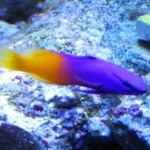
Royal Gramma
Common Name: Royal Gramma, Royal Gramma Basslet
Scientific Name: Gramma Loreto
Reef Safe: Yes
Temperament: Peaceful
Care Level: Easy
Max Size: 3 inches
Appearance:
The royal gramma is a very colorful little fish and will bring a lot of color and activity to any adequately set-up aquarium. The front half of the fish is a very bright purple color while the back half of the fish is a vibrant yellow color. The royal gramma will also have some dark markings near it’s eyes.
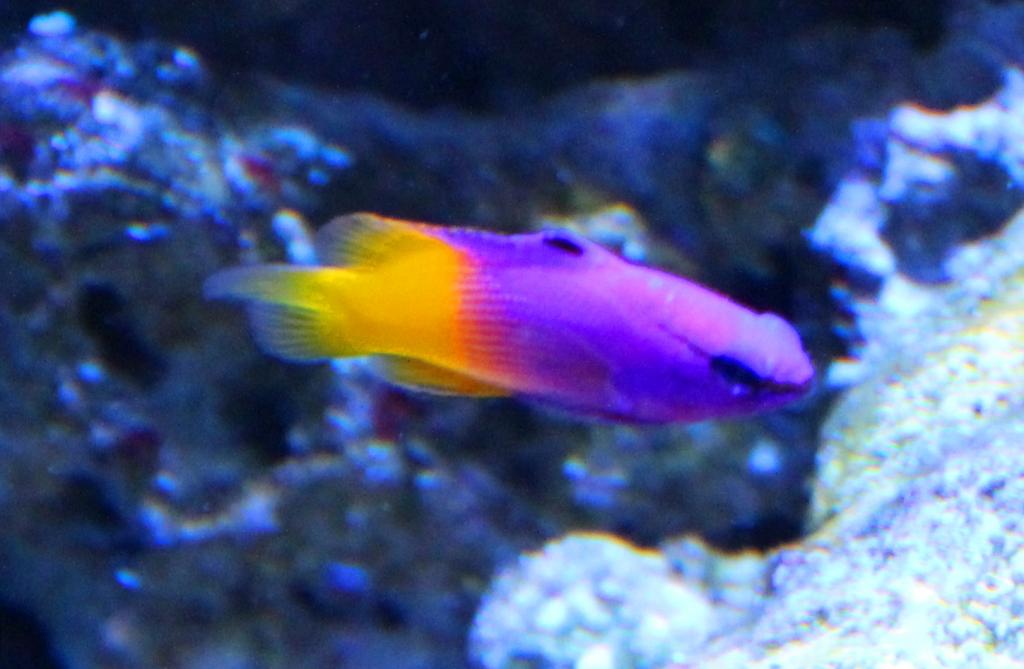
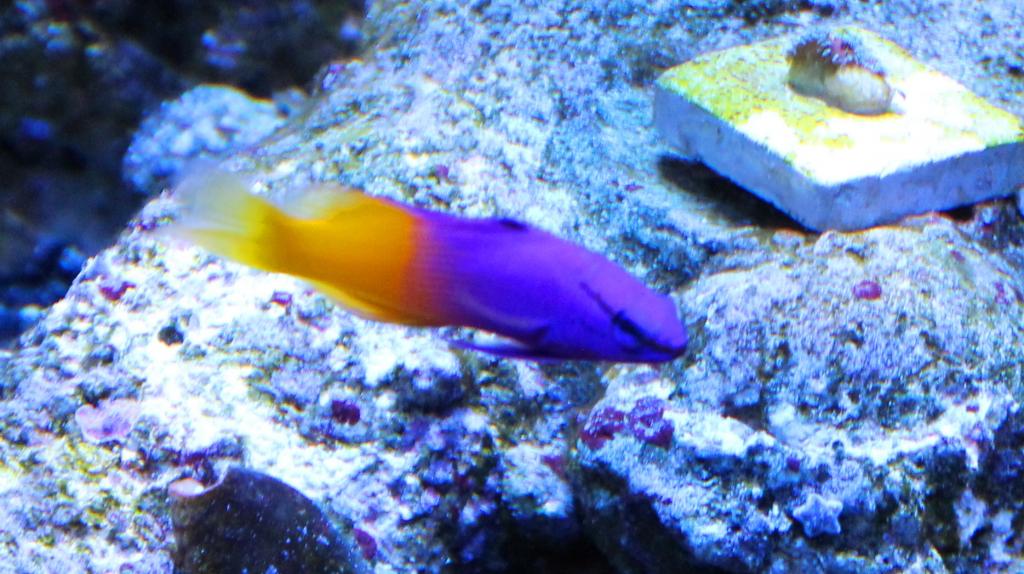
Temperament
Royal grammas are a very peaceful fish to have in an aquarium. You can keep them with any other peaceful fish . It is not recommended that you keep more than one royal gramma in your aquarium as they will get territorial and aggressive towards other royal grammas.
Environment
I would suggest the best minimum aquarium size for a royal gramma would be a standard 36 inch long 30 gallon tank Some hobbyists have claimed long term success keeping a royal gramma in a 29 gallon bio-cube. As they will need hiding spots, I would suggest an aquarium with a good amount of live rock which can provide them with at least a few cave like spots to hide in.
Recommended water conditions:
I would refer you to the below article for the typical water conditions that a royal gramma will do best in:
https://www.reefaquarium.com/2013/the-basics-of-marine-aquarium-water-parameters/
Diet
Royal grammas are carnivores, A diet consisting of a verity of meaty foods such as brine shrimp or mysis shrimp (as two examples) would be good options. The royal gramma would also benefit from a good quality marine flake food for carnivores.
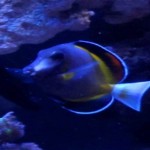
Powder Brown Tang
The below profile is on another one of the interesting tangs that I have kept. This information Powder brown Tangs is based on what I have learned and observed.
Common Name: Powder Brown Tang
Scientific Name: Acanthurus Japonicus
Reef Safe: Yes
Temperament: Peaceful for the most part
Care Level: Moderate
Max Size: 8 inches (around 6 inches is more common)
Appearance:
The powder brown tang has the typical oval shaped body, just as with most other tangs. As the common name suggests, it has brown coloring on its body. There are white marks on both cheeks as well as near the eyes and mouth. The fins are typically a darker shade of brown when compared to the brown on the body. The fins will also have a lighter blue colored highlights around the edges. The tail fin will have a little different coloring having a strong blue undertone to it as well as a yellow vertical bar. There will also be a yellow strip along the body separating the body and fins.
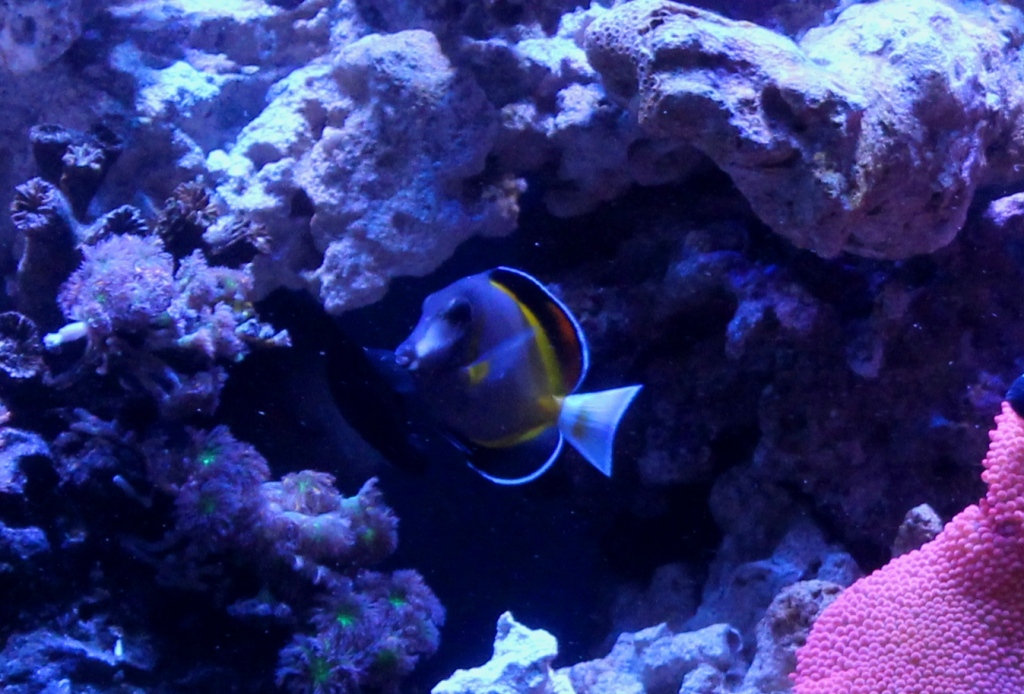
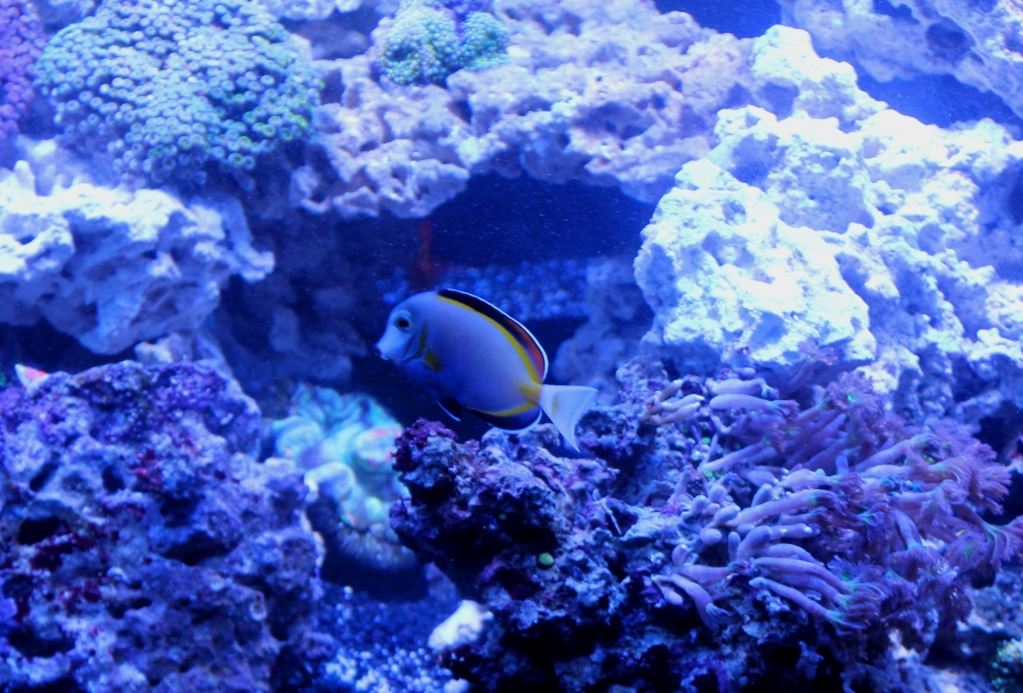
Environment and Temperament
Powder brown tangs can become semi-aggressive when kept with other tangs of a similar shape, size, and color to them and can also become aggressive with other powder brown tangs in the same aquarium. This behavior can actually be fairly common with most tangs. The powder brown tang however is a great fish for a community tank as they will peacefully co-exist with any other types of fish. They are also completely reef safe.
The Powder brown tang would to best in a tank size of 75 to 90 gallons or more. The reason for that recommendation is not only based on their average adult size of around 6 inches (give or take), but on their typical behavior as well. They are a very active fish requiring a lot of open swimming space in the tank. This makes the powder brown tang a very entertaining fish to have in a properly sized set-up.
The Powder brown tang will require suitable hiding spots so they can claim one as their own. It is typical for a Powder brown tang to find a spot they can hide in among the aquarium live rock and go there whenever they get spooked, scared, or stressed. The Powder brown tang really needs this “safe spot” to go to or they can become even more stressed reducing the effectiveness of their immune system and making them more susceptible to disease or parasites.
Recommended water conditions / parameters:
I would refer you to the below article for the typical water conditions that powder brown tangs will do best in:
https://www.reefaquarium.com/2013/the-basics-of-marine-aquarium-water-parameters/
Diet
As with most tangs, the powder brown tang will accept almost any food you may offer it. However, they are herbivores and will require a diet consisting mostly of sea algaes with some other verities of food on occasion. A good quality flake or pellet food meant for marine herbivores is also a good option for the Powder brown tang’s main diet.
A reference for your consideration
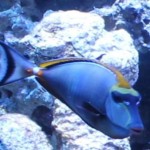
Blond Naso Tang
The below profile is on another one of the interesting tangs that I have kept. I have based this article on what I have learned and observed.
Common Name: Blonde Naso Tang, Elegant Tang, Orange spine surgeonfish, and Pacific Orangespine tang
Scientific Name: Naso elegans
Reef Safe: Yes
Temperament: Peaceful to semi-aggressive
Care Level: Moderate
Max Size: 16 to 18 inches (around 12 inches is more common)
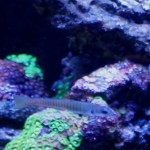
Zebra Barred Dartfish
The below Dartfish profile is based on what I have learned and observed while keeping these fish. They certainly are active little fish to keep and will add a lot of viewing pleasure to any aquarium.
Common Name: Zebra Barred Dartfish, Zebra Dart Goby, Bar Goby, Barred Dartfish, Zebra Goby, and Chinese Zebra Goby
Scientific Name: Ptereleotris zebra
Reef Safe: Yes
Temperament: Peaceful
Care Level: Easy
Max Size: 3 to 5 inches (around 4 inches is more common)
Appearance:
They are a small and comparatively long fish with a grey to green colored body and several black bars or stripes on them that have a very slight yellow to light green boarder on both edges of the black bars.
As you can well imagine, getting a good picture of a very small and fast moving fish can be a challenge for someone like me with limited photography skills, but the below are some pictures of my Zebra Dartfish
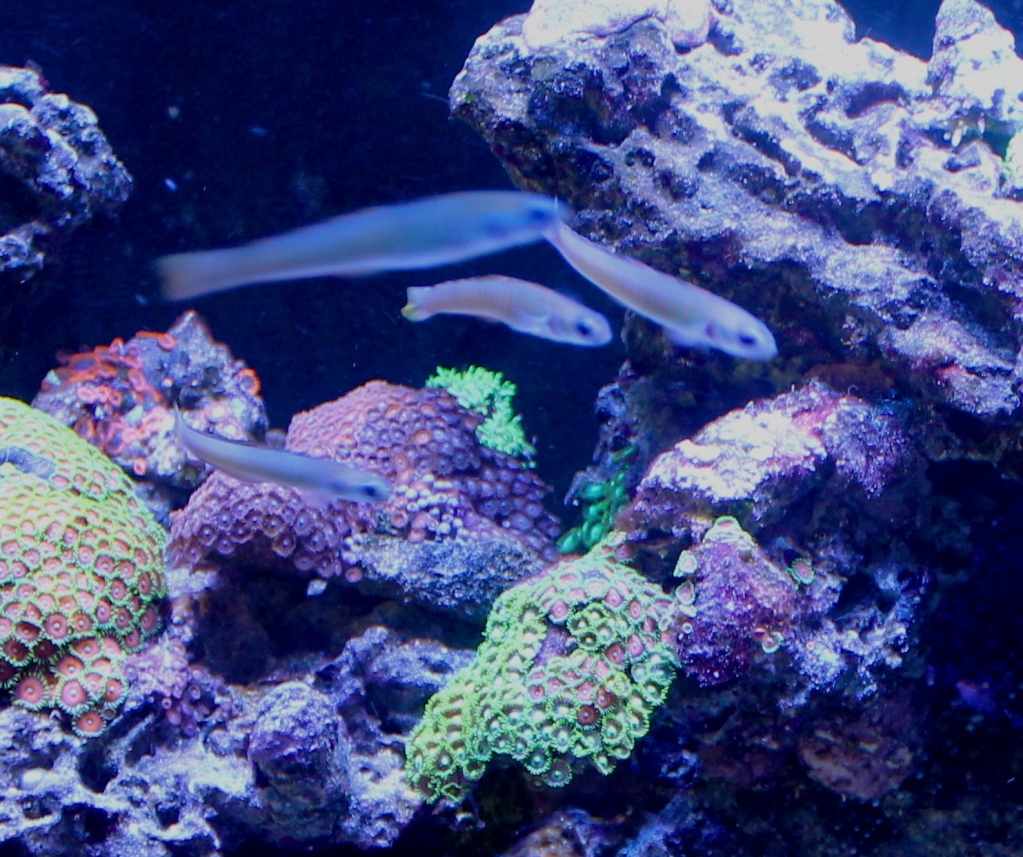
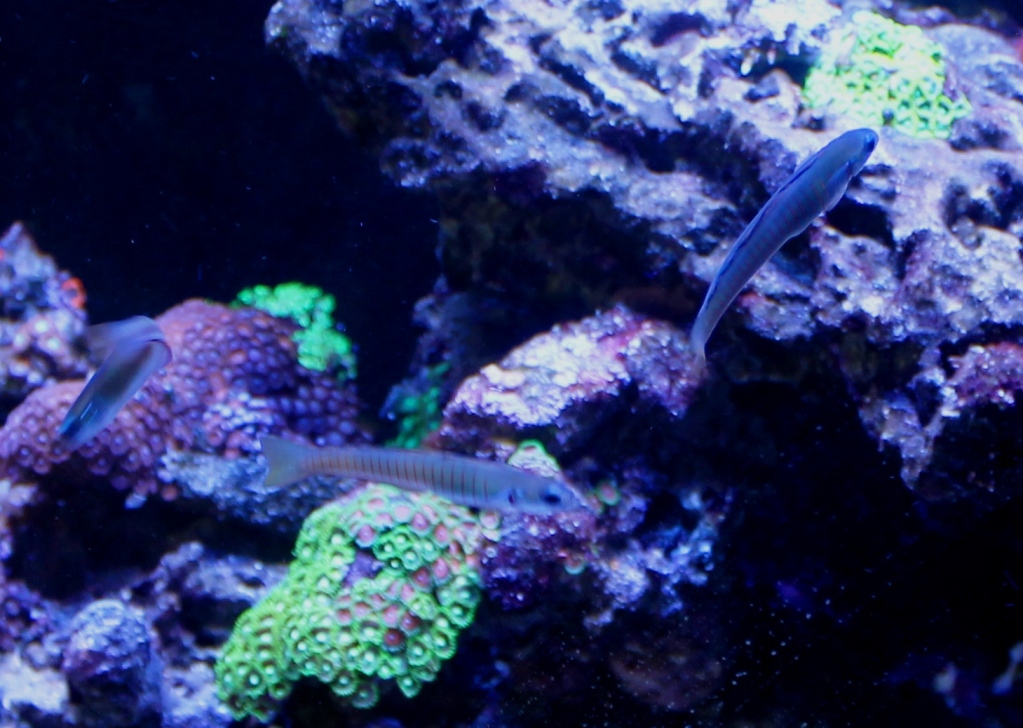
Temperament
Zebra Dartfish are great community fish. They are very peaceful and reef safe. They are very active and very fast swimmers and should be kept with other fish that will not get spooked by their activity level and fast movements of this Dartfish. They are a schooling fish so you will need to keep at least 6 of them together in the same tank. Based on my experience with them, they seem to do better when you have 8 or more which is why I would recommend keeping them in schools of 10. They work very well as dither fish potentially allowing other fish to feel more comfortable through seeing other fish swimming around in the aquarium.
Environment
Although this is a small fish, the Zebra Dartfish is a very active fish and should be kept in a 48 inch long tank to allow for the minimum amount of open swimming spaces which they typically need. You will also need to have some hiding spots for these fish to go to when they feel stressed or threatened. A lot of small hiding spots in your live rock throughout the aquarium will work best for these fish. Zebra Dartfish need a tank with a closed top as they have been known to jump out of the tank very often when kept in a open top tank.
Recommended water conditions:
I would refer you to the below article for the typical water conditions that a Zebra Dartfish will do best in:
https://www.reefaquarium.com/2013/the-basics-of-marine-aquarium-water-parameters/
Diet
Zebra Dartfish are carnivores. They will do best with a wide range of meaty foods like brine shrimp or mysis shrimp just to name two of them. Just make sure it is a food that is small enough for the Zebra Dartfish to get in its mouth. A good quality flake or proper sized pellet food for marine carnivores would also be a good option.
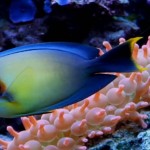
Mimic Tangs
The below profile is on one of the more interesting tangs that I have kept and is based on what I have learned and observed.
General Info:
Common Name: Mimic Tangs,
Scientific Name: Acanthurus Pyroferus (Yellow Mimic Tang), Acanthurus Tristis (Eibli Mimic Tang)
Reef Safe: Yes
Temperament: Can be Semi-Aggressive
Care Level: Easy to Moderate
Max Size: 10 in / 25 cm (7 to 8 inches is more common)